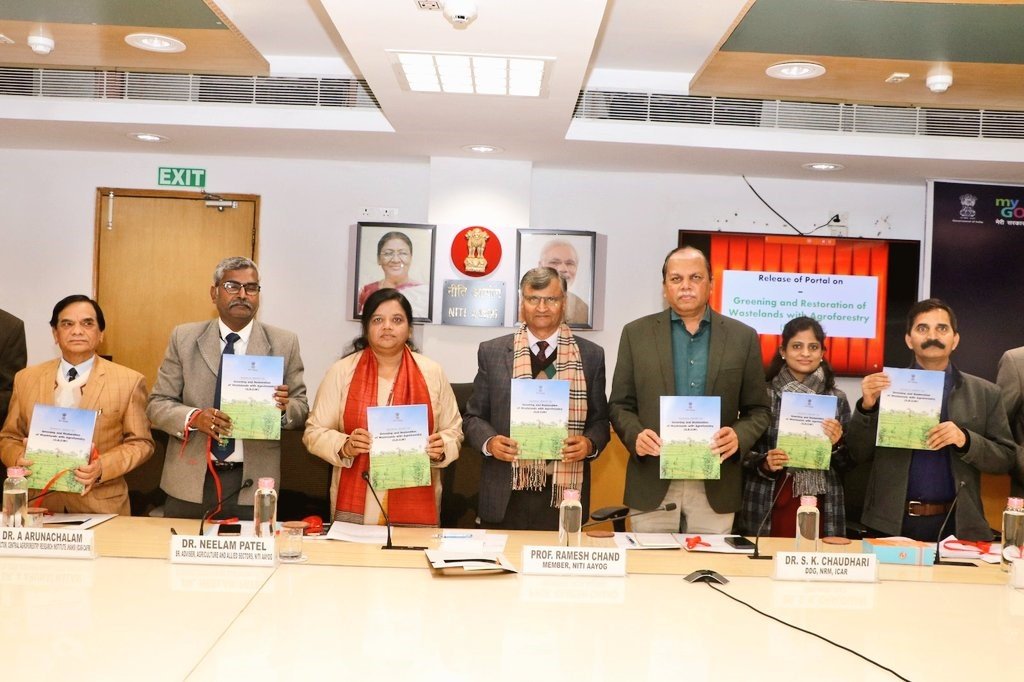The Greening and Restoration of Wasteland with Agroforestry (GROW) report and portal was launched on February 12 Prof Ramesh Chand, Member, NITI Aayog at NITI Aayog, reported the PIB. This multi-institutional effort led by NITI Aayog utilized remote sensing and GIS to assess agroforestry suitability across all districts in India. Using thematic datasets, an Agroforestry Suitability Index (ASI) was developed for national-level prioritization. The report provides state-wise and district-wise analysis, supporting government departments and industries for greening and restoration projects.
The “Greening and Restoration of Wasteland with Agroforestry (GROW)-Suitability Mapping” portal Bhuvan https://bhuvan-app1.nrsc.gov.in/asi_portal/ allows universal access to state and district-level data.
Currently, agroforestry covers 8.65 percent of India’s total geographical area, totalling about 28.42 million hectares. The current report underscores the potential benefits of converting underutilized areas, especially wastelands, for agroforestry. The GROW initiative aligns with national commitments, aiming to restore 26 million hectares of degraded land by 2030 and create an additional carbon sink of 2.5 to 3 billion tonnes of carbon dioxide equivalent.
During the release, Prof Ramesh Chand, Member, NITI Aayog shared that there is need for promotion of agroforestry especially for three objectives i.e reducing import of wood and wood products, carbon sequestration to combat climate change at global and national level and addressing sub-optimal use of arable land. It was shared that fallow land and culturable wastelands can be converted to productive use through agroforestry. Chand informed that the project will reap long term benefits and promote use of space technology in agriculture.
Download Nagaland Tribune app on Google Play

During the panel discussion, Dr SK Chaudhari shared that the portal will be helpful in different programmes as the Government of India is working to promote agroforestry and sensitizing role of extension. Panelists joining the session to scale-up agroforestry in greening and restoration were Dr A Arunachalam, Director, ICAR-Central Agroforestry Research Institute Jhansi, Dr. R Ravi Babu, GM, FSDD, NABARD, Dr Ravi Prabhu, Director Innovation, Investment and Impact CIFOR-ICRAF and Dr Rajiv Kumar, Group Head, RSA, NRSC, Hyderabad.
Due to the significance of goods and services provided by agroforestry, the Union Budget of Government of India (FY-2022-23) has underlined the promotion of agroforestry and private forestry as a priority. India, the seventh-largest country globally, faces issues like increased build-up areas, degraded land, and imbalanced resources. Approximately 16.96 percent of the Total Geographical Area (TGA) is wasteland, requiring transformation for productive use. Geospatial technologies and GIS are employed to map and prioritize these wastelands for agroforestry interventions.
India, the pioneer of the National Agroforestry Policy in 2014, aims to enhance productivity, profitability, and sustainability through this agroecological land use system. Agroforestry integrates trees, crops, and livestock, addressing food, nutrition, energy, employment, and environmental challenges. This aligns with global commitments like the Paris Agreement, Bonn Challenge, UN Sustainable Development Goals, United Nations Convention on Combating Desertification (UNCCD), Doubling Farmers Income, Green India Mission and more, reported the PIB.

